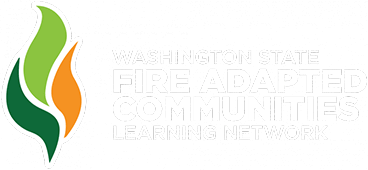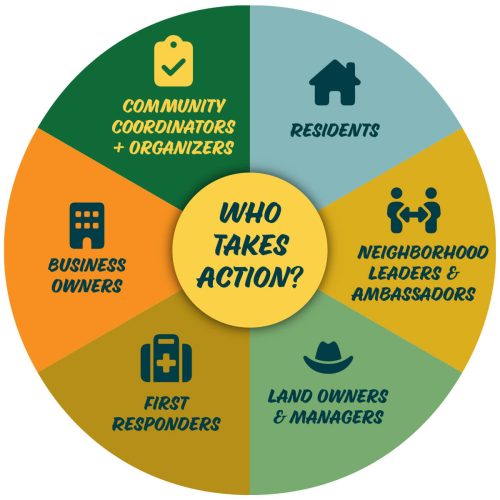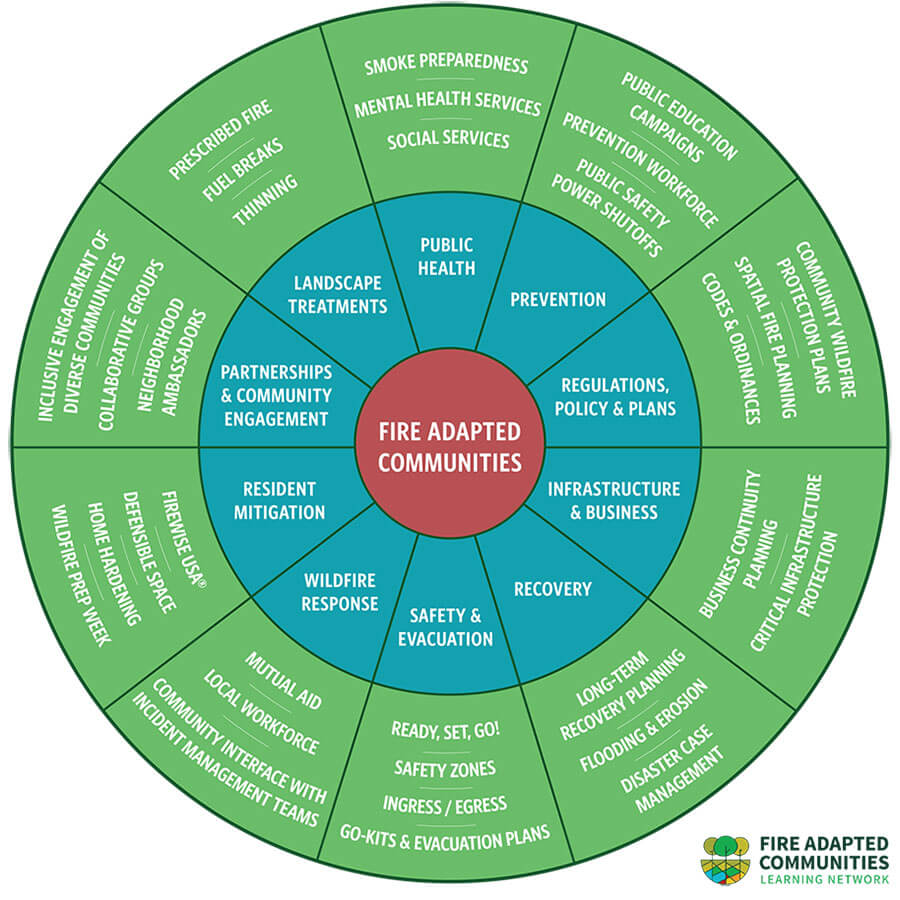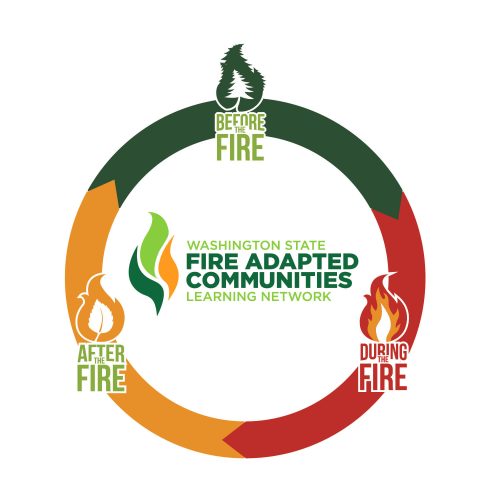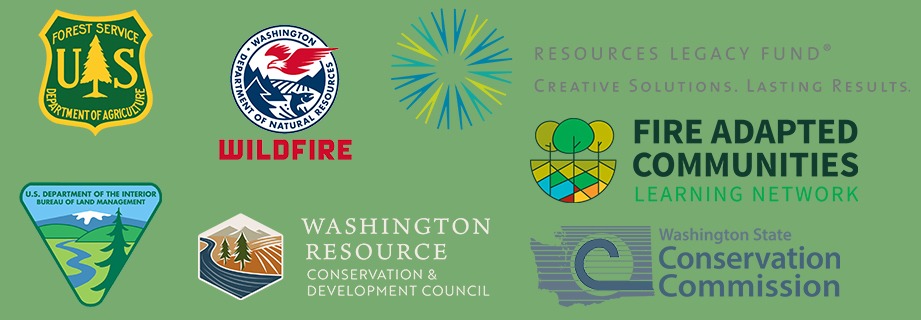Fire adaptation is for everyone
Step outside in Washington, and you are likely standing on a landscape shaped by fire. Topography, vegetation, and weather all shift how fire behaves.
But what doesn’t shift is the attachment – to our place, to each other, and to the gifts, challenges, and responsibilities that wildfire brings to Washington.
what are fire adapted communities?
“Fire adapted communities” or (FAC) are communities that understand their risk and are taking action to better prepare for, respond to and recover from wildfire. In Washington, fire adaptation means accepting fire as part of the surrounding landscape, taking action to reduce risk and the need for extensive protection actions, and continuously adapting to live safely with wildfires.
When we talk about fire adapted communities, we talk about action:
who takes action?
Because everyone is at risk, everyone shares responsibility. Whether we are approaching wildfire personally or through work, we can take action in the ways at the scale that make sense for us. As individuals, we can prepare our families, homes, and neighbors. Or we may be in a position where we can make a difference in our towns, counties, watersheds, state, or even at a national level. Fire knows no boundaries, and so we must work across ours.
We encourage you to collaborate locally and identify actions that will change fire outcomes in your community. Let’s get to work.
EVERYONE HAS A ROLE TO PLAY.
Within the community fire adaptation framework, everyone shares responsibility.
When taking on fire adapted communities work, it is important to ask who is at the table, who is not at the table, who you could be working with, and what might be possible if you work together.
This effort is large and complex and we need all hands on deck – and we need to tap into our collective creativity, tools, knowledge, and understanding, and listen to a diversity of perspectives to make this work and fit the unique context of our special place.
There are no constraints on each role – and we can’t do it alone.
- Community members can reduce the potential for home ignition and take part in community-wide discussions to reduce fire risk.
- Local governments can create policies, regulations, and resources to help communities become more resilient.
- Environmental and fire management agencies and organizations can provide technical assistance and resources to help prepare and recover from wildfires.
And so much more.
WHAT IS YOUR ROLE?
You may take on many different roles in your community fire adaptation efforts. Below you will find resources specific to those roles and to help you be better prepared for, to respond to, and recover from wildfire.
WHAT ACTIONS CAN PEOPLE TAKE TO BECOME FIRE ADAPTED?
Actions to improve a community’s resilience to wildfire can vary from place to place. The goal is to decrease the impact of wildfire to the community.
Evacuation planning, developing community wildfire protection plans, adopting wildland-urban interface codes, controlled burning, and planning for post-fire recovery are a few examples of fire adaptation actions.
A community may experience wildfire many times; however, communities can lessen or change the impact by taking more actions to better live with wildfire.
CREATE A TAILORED ‘PATHWAY’ FOR COMMUNITY FIRE ADAPTATION
FAC is not a one-size-fits-all approach; actions will vary from place to place.
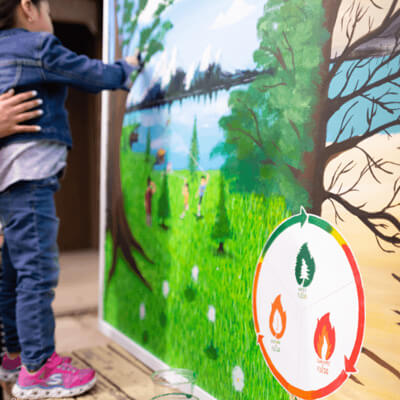
The fire adapted communities framework is broad and open ended, which can make it difficult to navigate. One common question community members and practitioners ask is, “Where do I start?”
The FAC Pathways Tool attempts to answer that question. The tool can help you determine a ‘pathway’ for identifying potential programs, grants or asssitance, or practices and projects to organize around and implement that may be the most effective for your place. It can help guide you to select specific fire adaptation practices, considerations for success, and an action guide.
TAKE ACTION THROUGHOUT THE FIRE CYCLE
Communities can start living better with wildfire at any point – before, during, and after a fire.
Community preparedness, response, and recovery are not linear – and taking action before, during, and after a fire may occur at the same time in a community.
A community is never done with wildfire adaptation – and there is no end or designation. A resilient community continuously assesses and adapts to changing social, political, and ecological conditions.
wildfire information and resources
WASHINGTON WILDFIRE RESOURCES
In Washington, we are working with partners and WAFAC members to curate and create resources unique to our State – and tailored for you.
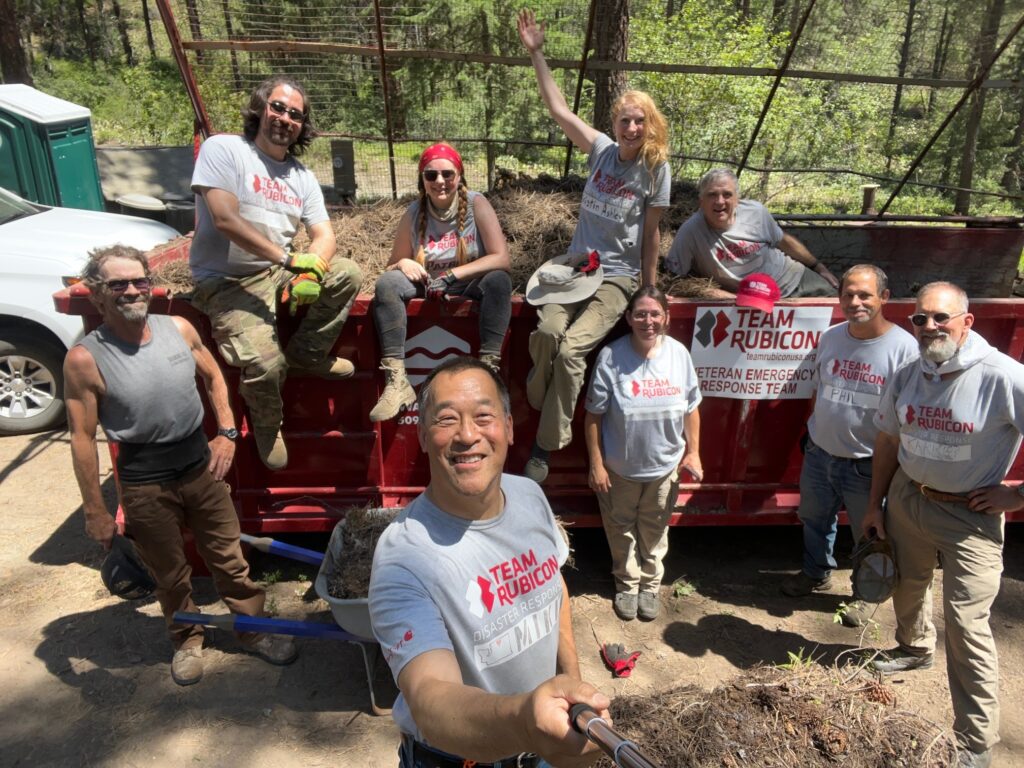
FAC RESOURCES FROM ACROSS THE NATION
There are a variety of actions one can take to build community resilience to wildfire.
The National Fire Adapted Communities Learning Network has pulled together a searchable database of resources from across the nation.
STATE AND FEDERAL ASSISTANCE PROGRAMS
State and federal entities offer community wildfire assistance programs focused on cooperation and collaboration. They provide funding and technical expertise for hazardous fuel reduction on non-federal lands, Community Wildfire Protection Plans (CWPPs), prevention efforts to reduce human-caused fires, wildland fire training for fire departments, and rangeland fire protection associations (RFPAs), business continuity planning, and community recovery efforts. Check-out a few resources available in our State.
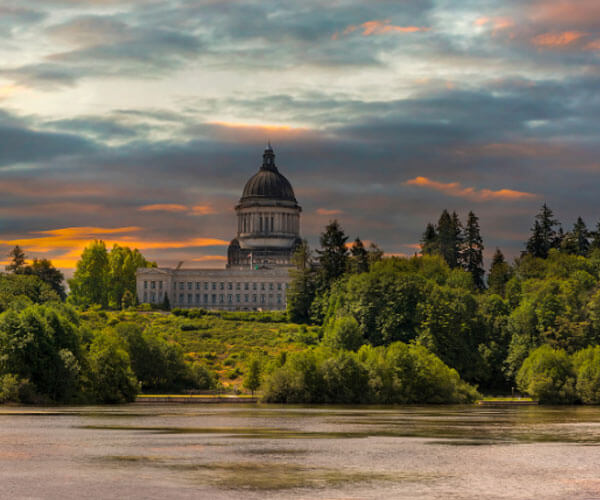
Financial Assistance Programs
- FEMA grant funds are available for pre and post-emergency or disaster-related projects. These funds support critical recovery initiatives, innovative research, and many other programs.
- Check-out these blogs from the national Fire Adapted Communities Learning Network: “Post Fire Recovery Resource Round-up” and “Understanding Post Fire Federal Resources“
- Washington Emergency Management offers Disaster Assistance for individuals, businesses, government, public assistance, and community organizations and grants for state and local jurisdictions.
- Non-federal owners of fewer than 5,000 acres of forestland seeking to improve forest health and reduce the threats of wildfire and bark beetle damage are eligible to sign-up for cost-share opportunities for Central and Eastern Washington.
- USDA is here to help you prepare, recover, and build long-term resilience to natural disasters. Visit https://www.farmers.gov/recover for more information and to get started.
- USDA’s Natural Resource Conservation Service helps agricultural producers and communities through the Environmental Quality Incentives Program (EQIP) and the Emergency Watershed Program (EWP) to quickly address serious and long-lasting damages to infrastructure and to the land after disasters, including wildfires.
- USDA’s Farm Service Agency (FSA) offers disaster assistance and low-interest loan programs to assist agricultural producers in their recovery efforts following wildfires or other qualifying natural disasters. For more information on these programs, visit or contact your local FSA office.
